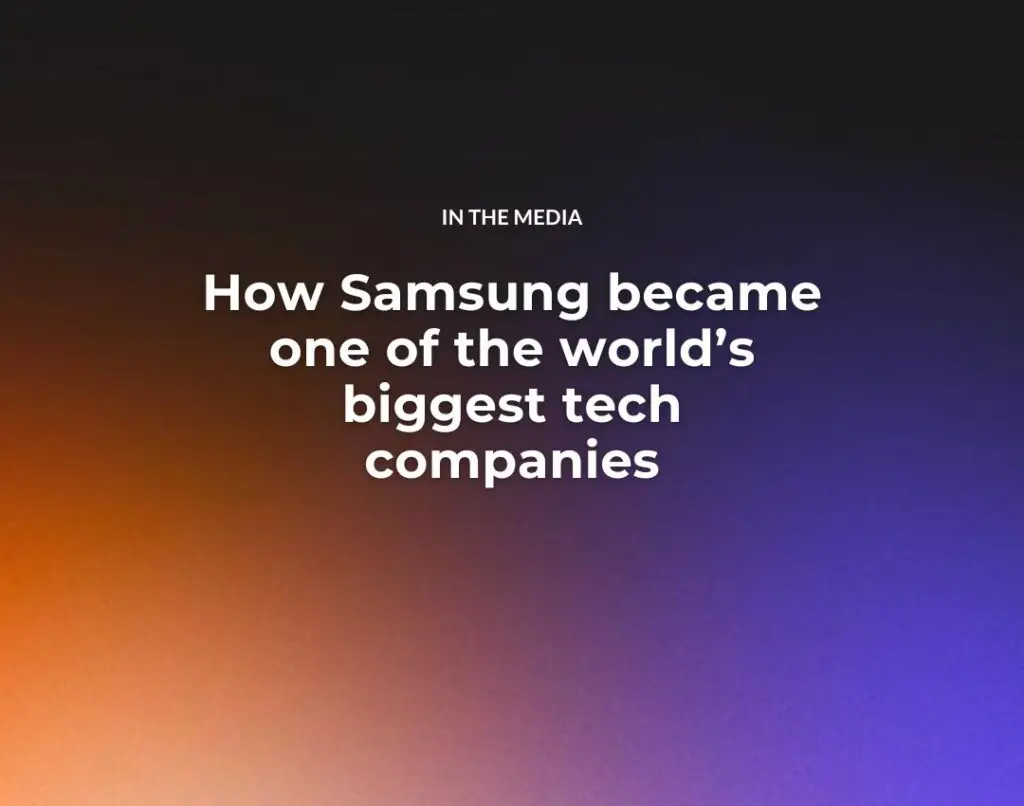By Andie Corban and Kai Ryssdal
Marketplace
Mar 17, 2020
The following is an excerpt from Geoffrey Cain’s new book “Samsung Rising: The Inside Story of the South Korean Giant That Set Out to Beat Apple and Conquer Tech,” about the South Korean company’s journey from grocery store to tech giant.
ONE DAY IN SEPTEMBER, the U.S. division’s South Korean dispatcher (its liaison with Samsung headquarters), a man named Ji, hurried into the office, frantic and fearful. A plane full of auditors from Samsung headquarters was on the way from Korea to go through the American team’s books. They would land in a few hours.
“Help them and be open,” Ji said. He told his team to give them “whatever they need.”
For three weeks, the American marketing team was forced to go through their records, proving their successes.
“They were accused of bribing the media, falsifying sales, and a bunch of other damaging claims that hurt morale in the office,” reported Business Insider’s Steve Kovach. “The same US-based office that helped turn Samsung into a brand as recognizable as Apple was suddenly being punished for its work.”
This is our reward for success? Todd’s people wondered.
While his employees were distracted by the audits, Pendleton managed to keep his head held high. For him, the audits weren’t something to fear. Samsung’s headquarters just wanted to learn what his team was up to. Employees claimed that it was his unrelenting optimism that was the magic behind his success.
The auditors found nothing out of the ordinary. And the team’s feeling of being under attack by South Korean headquarters had the unintended consequence of strengthening the sense of unity among Pendleton’s high-performing marketers, bringing them closer together as a tribe.
Whatever the executives at Samsung’s headquarters in Seoul thought, the team’s “Next Big Thing” commercial garnered seventy million online views. It was the most popular tech ad of 2012.
Todd was ecstatic when he opened The Wall Street Journal on January 28, 2013, to an uncanny story.
“Has Apple Lost Its Cool to Samsung?” the headline read.
“Samsung, the market leader in smartphones, on Friday said its fourth-quarter profit surged 76% to a record high on the strength of smartphone sales, including its Galaxy S line. The latest version is considered comparable by many shoppers in both design and technical features,” wrote tech reporters Ian Sherr and Evan Ramstad.
“Apple, meanwhile, reignited concerns about demand for its iPhone 5 after reporting flat earnings for the holiday quarter, sending its stock down 14% in the past two days. The stock has also dropped 37% since hitting an all-time high on Sept. 19, just two days before the iPhone 5 launched in stores.”
The Wall Street Journalpiece pointed to Pendleton’s “marketing onslaught” that had allowed Samsung to close the “coolness gap with Apple Inc.” The article riveted the tech industry.
But the Super Bowl was fast approaching (six days away), and Pendleton wasn’t finished attacking Apple’s position in the marketplace. He had a new $15 million ad-libbed commercial set to air during the Super Bowl, made with 72andSunny, featuring comic banter among Paul Rudd and Seth Rogen and “Breaking Bad”‘s Bob Odenkirk, plotting their own fictional ad spot for the Super Bowl.
“We actually can’t say ‘Super Bo—’?” asked Seth Rogen.
“No! It’s trademarked,” snapped back Bob Odenkirk. “You get sued!”
“Can I say ‘San Francisco’?”
“Sure.”
“But I can’t say ‘the forty-nine—’?”
“Eee!”
“Can we say ‘the San Francisco fifty minus ones’?”
“Love it.”
The commercial was more a brand-building exercise than an effort to sell more phones, poking fun at Apple’s lawsuit. Samsung was riding a powerful wave of positive publicity.
Forbes described the ad as “a barrage of not-so-subtle jabs at competitor Apple Inc.”
Phil Schiller, Apple’s senior vice president for marketing, was livid at Samsung’s marketing campaign. He shot an email to Apple’s ad agency, TBWA\Chiat\Day, with a link to the Wall Street Journal article.
“We have a lot of work to do to turn this around,” he wrote. He emailed Apple CEO Tim Cook that Apple “may need to start a search for a new agency.”
“We feel it too and it hurts,” wrote an advertising executive at TBWA back to Schiller. “We understand that this moment is pretty close to 1997 in terms of the need for advertising to help pull Apple through this moment.”
Schiller blew up at the response.
“To come back and suggest that Apple needs to think dramatically different about how we are running our company is a shocking response,” he wrote.
“In 1997 Apple had no products to market. We had a company making so little money that we were 6 months from out of business. . . . Not the world’s most successful tech company. Not the company that everybody wants to copy and compete with.”
Samsung’s Super Bowl ad was “pretty good,” Schiller went on, “and I can’t help but think these guys [TBWA] are feeling it, like an athlete who can’t miss because they are in the zone while we struggle to nail a compelling brief on iPhone.”
In response to Samsung’s new marketing savvy around new releases of its Galaxy phones, Apple seemed to follow Samsung’s lead in terms of new products, expanding Apple’s limited lines to include bigger screens, additional sizes of iPhones, and more variety for a wider swath of customers.
“Consumers want what we don’t have,” read a gloomy Apple presentation slide in February 2013, lamenting that growth was slowing, that people were crying for bigger screen sizes. It was an idea that Samsung had pioneered.
Advertising at Apple, too, needed a reboot. As Pendleton was lampooning Apple, the company had already been releasing commercials around the “Genius Bar,” featuring a feisty, squeaky-voiced fix-it geek running around telling people about basic features on their Apple products on an airplane, at someone’s front door, and on a city street. The spots were called “embarrassing” by The Verge and so derided by loyal Apple followers that Apple pulled them.
In 2013 Apple raised its U.S. mobile phone advertising budget from $333 million the previous year to $351 million. (Samsung had a $401 million budget in 2012.) It brought its advertising work in-house and forced its traditional outside agency to compete with Apple’s in-house talent.
As Apple struggled to get its mojo back, Samsung was already moving forward with its next assault, this time in software.
Excerpted from “SAMSUNG RISING: The Inside Story of the South Korean Giant That Set Out to Beat Apple and Conquer Tech” © 2020 by Geoffrey Cain. Published by Currency, an imprint of Penguin Random House LLC. No part of this excerpt may be reproduced or reprinted without permission in writing from the publisher.
Read more about Geoffrey Cain’s new book, Samsung Rising at Marketplace
See also:





